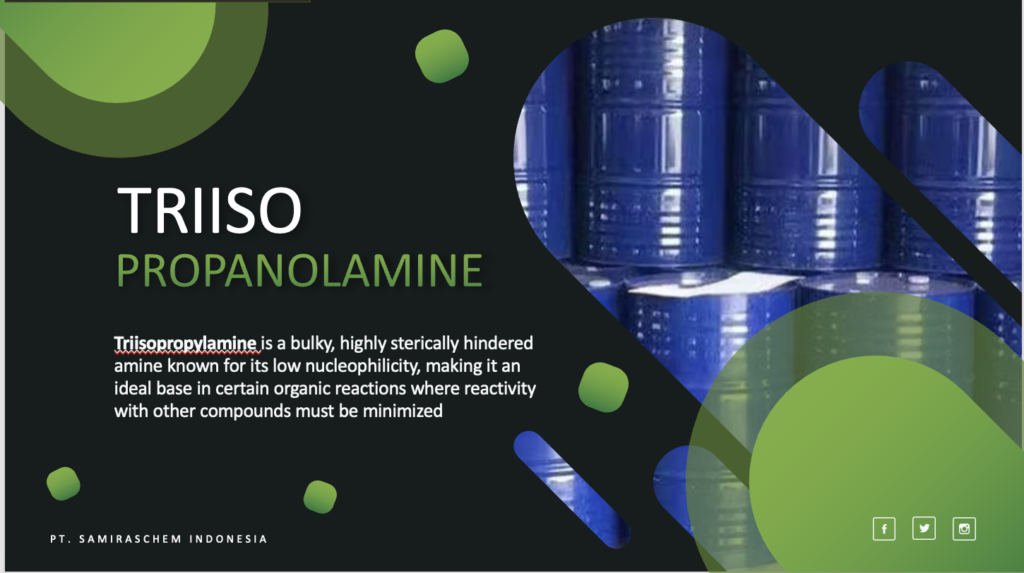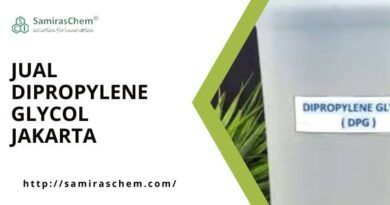Jual Triisopropylamine
Jual Triisopropylamine is a bulky, highly sterically hindered amine known for its low nucleophilicity, making it an ideal base in certain organic reactions where reactivity with other compounds must be minimized.
Triisopropylamine: An Overview Jual Triisopropylamine
Chemical Formula: C9H21N
Molecular Weight: 143.27 g/mol
IUPAC Name: N,N-Diisopropylpropan-2-amine
As a tertiary amine, triisopropylamine has three isopropyl groups attached to the nitrogen atom, giving it significant steric bulk and affecting its reactivity and basicity.
- Appearance: Triisopropylamine is a clear, colorless to pale yellow liquid with a mild, amine-like odor.
- Boiling Point: Approximately 173°C
- Melting Point: -45°C
- Solubility: Sparingly soluble in water but highly soluble in many organic solvents, including ethanol, ether, benzene, and acetone.
- Density: 0.768 g/mL at 20°C
- Basicity: Despite being a strong base, TIPA’s bulky structure reduces its ability to participate in certain nucleophilic reactions, which makes it an effective “non-nucleophilic base.”
Production and Synthesis
Jual Triisopropylamine can be synthesized using several approaches, but one common method is through alkylation of ammonia or primary amines with isopropyl halides (e.g., isopropyl chloride or bromide) under controlled conditions.
Another method includes:
- Reductive Amination: Starting from acetone and reacting it with ammonia in the presence of hydrogen and a metal catalyst (like platinum or nickel), the process selectively adds isopropyl groups to form triisopropylamine.
The production process requires precise control to prevent the formation of side products and to ensure that all three nitrogen sites are bonded with isopropyl groups, yielding a pure TIPA product.
Uses of Triisopropylamine
Jual Triisopropylamine low nucleophilicity and strong basicity make it valuable in a wide range of applications:
- Organic Synthesis: TIPA is particularly useful as a base in synthetic reactions where steric hindrance is necessary to prevent unwanted side reactions. It can neutralize acids generated in reactions without interacting with sensitive substrates, making it a popular choice for:
- Aldol Condensation Reactions
- Esterifications and Acylations
- Deprotonation Reactions in Peptide Synthesis
- Pharmaceutical Industry: In pharmaceutical synthesis, TIPA is employed in reactions where minimal nucleophilicity is required, such as in the formation of certain active pharmaceutical ingredients (APIs). Its properties make it an ideal reagent in multi-step synthesis processes for complex drug compounds.
- Polymer and Resin Processing: TIPA acts as a catalyst or base in the production of certain polymers and resins, where its steric bulk helps control reaction rates and product structure. For example, it is used in producing epoxy resins and polyurethane foams, helping to regulate cross-linking reactions that influence the mechanical properties of the final material.
- Environmental Chemistry and Agricultural Applications: TIPA derivatives are sometimes used in the production of herbicides and pesticides, acting as intermediates in the synthesis of agrochemical products. Due to its stability and non-nucleophilicity, TIPA derivatives contribute to the targeted activity of agrochemicals.
Handling and Storage
Jual Triisopropylamine is generally stable under normal conditions, but, like many organic amines, it requires careful handling due to its flammability and potential health hazards.
- Personal Protective Equipment (PPE): It is recommended to wear protective gloves, goggles, and clothing when handling TIPA. Avoiding direct contact and working in a well-ventilated area is essential.
- Storage Conditions: TIPA should be stored in a cool, dry, and well-ventilated area, away from sources of ignition and incompatible substances such as acids and oxidizing agents.
- Handling Precautions: Due to its flammability, avoid open flames or sparks in areas where TIPA is used. It is also recommended to store TIPA in airtight containers to minimize vapor release and maintain product integrity.
Health Hazards and Safety Measures Jual Triisopropylamine
Acute Exposure: Short-term exposure to TIPA can cause respiratory irritation, skin and eye irritation, and, in some cases, symptoms like dizziness or headache due to inhalation of vapors. Prolonged skin contact can cause dermatitis or more severe irritation.
Chronic Exposure: Long-term exposure can potentially affect liver and kidney function, though such effects are more likely in cases of high and repeated exposure. There is limited evidence on TIPA’s carcinogenicity, but it is generally advisable to avoid prolonged exposure.
First Aid Measures:
- Inhalation: Move the individual to fresh air immediately and seek medical help if symptoms persist.
- Skin Contact: Rinse thoroughly with water and remove contaminated clothing. Consult medical advice if irritation occurs.
- Eye Contact: Flush the eyes with plenty of water for at least 15 minutes and seek medical attention if irritation continues.
- Ingestion: Do not induce vomiting; instead, rinse the mouth and seek medical assistance immediately.
PT. Samiraschem Indonesia is Reliable Supplier and Distributor Triisopropylamine with High Quality Product and Good Price. We are Serving and Delivered Area such Jakarta Bandung Semarang Jogja Surabaya Medan and Batam
Jual Triisopropylamine Due to its potential toxicity to aquatic organisms, TIPA should be managed carefully to avoid release into the environment. Its volatility and persistence mean that it can contribute to air pollution if not contained properly.
Disposal of TIPA should align with local environmental regulations. Methods for safe disposal include:
- Chemical Neutralization: TIPA can be neutralized and diluted in a controlled environment before disposal. This is usually performed by professional waste management services.
- Licensed Disposal Facilities: Sending TIPA to licensed facilities ensures safe handling, neutralization, and proper waste treatment to minimize environmental impact.
Jual Triisopropylamine is a versatile, highly sterically hindered tertiary amine used in organic synthesis, pharmaceutical manufacturing, polymer processing, and agriculture. Its bulky structure and unique properties allow it to serve as a non-nucleophilic base, making it particularly valuable in reactions sensitive to nucleophilic interference. However, its handling requires caution due to potential health and environmental hazards.


